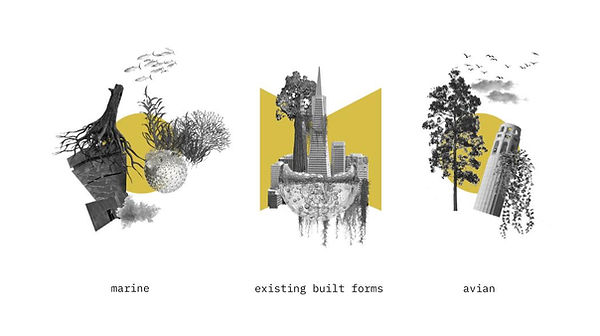2021
SAN FRANCISCO 2.0
the fall of the anthropocene
In order to keep the city standing, scientists and biologists develop a new tree species to support infrastructure... but it backfires.
CONTEXT
ARC 920 : Advanced Architecture Studio,
Ryerson University
LOCATION
San Francisco
SOFTWARE
3ds Max, Corona Render, Photoshop, Rhinoceros3D, Illustrator
SUPERVISOR
Vincent Hui
COLLABORATORS
Shengnan Gao, Jiaqi Liu
2200: the apex of human civilization.
Situated along the San Andreas fault or The Ring of Fire, the San Francisco area is known for active volcanoes and frequent earthquakes. The city is built upon landfills and historic marshland which is susceptible to ground liquefication in the aftermath of a major earthquake.
Scientists begin to explore the possibilities of cross-breeding Giant Sequoia trees with Strangling Figs to support the infrastructure of the city. By interbreeding these two species of flora, scientists of the past were able to develop a revolutionary form of infrastructure, which was able to structurally support the city, raise it above sea level and densify it.
In the Apex of civilization, the major and frequent earthquakes have altered the bay area with permanent fissures and new water ways. San Francisco’s architecture became composed of a combination of living organisms and manufactured materials. Architecture entered a new era, when chemistry, biology, and engineering dominated the industry, using nature as a vehicle for urbanism.













4200: the post-anthropocene.
Along with the introduction of vegetation into the city, various fungi begin to invade urban spaces. Eventually, the city becomes unlivable due to the overgrowth of harmful fungi, leaving San Francisco devoid of human presence. The fissures and canyons created by the initial earthquake widens and along with the influx of extreme weather conditions, the up-keep of the expansive root system stops and water consumes major coastal areas. Buildings, wrapped in the cross-bred plantings, were invaded by creatures and plants, becoming natural habitats, originally constructed by human beings. The fungal growths on trees aid the trees in their growth and development. Three unique ecosystems formed by the combination of sequoia trees and urban remnants emerge, creating a mangrove-like condition in the city. Creatures begin to inhabit the marine, terrestrial and avian environments.
The city has been reclaimed by nature.










